
PYMNTS has surveyed consumers and businesses for more than a year about what life after the pandemic would be like.
The U.S. has mobilized the largest COVID-19 vaccination rollout of any country in the world. The Biden administration has set May 1 as the date that all states will be required to lift vaccine requirements to include any adult who wants to get the jab. President Biden says he’s hopeful that the U.S. will be ready to celebrate a return to normalcy come July 4. After a year of living life under lockdown, all of that is certainly welcome news.
Why, then, do most Americans still think it will take until this time next year — March of 2022 — before a return to the physical world as they left it in March of 2020 is likely?
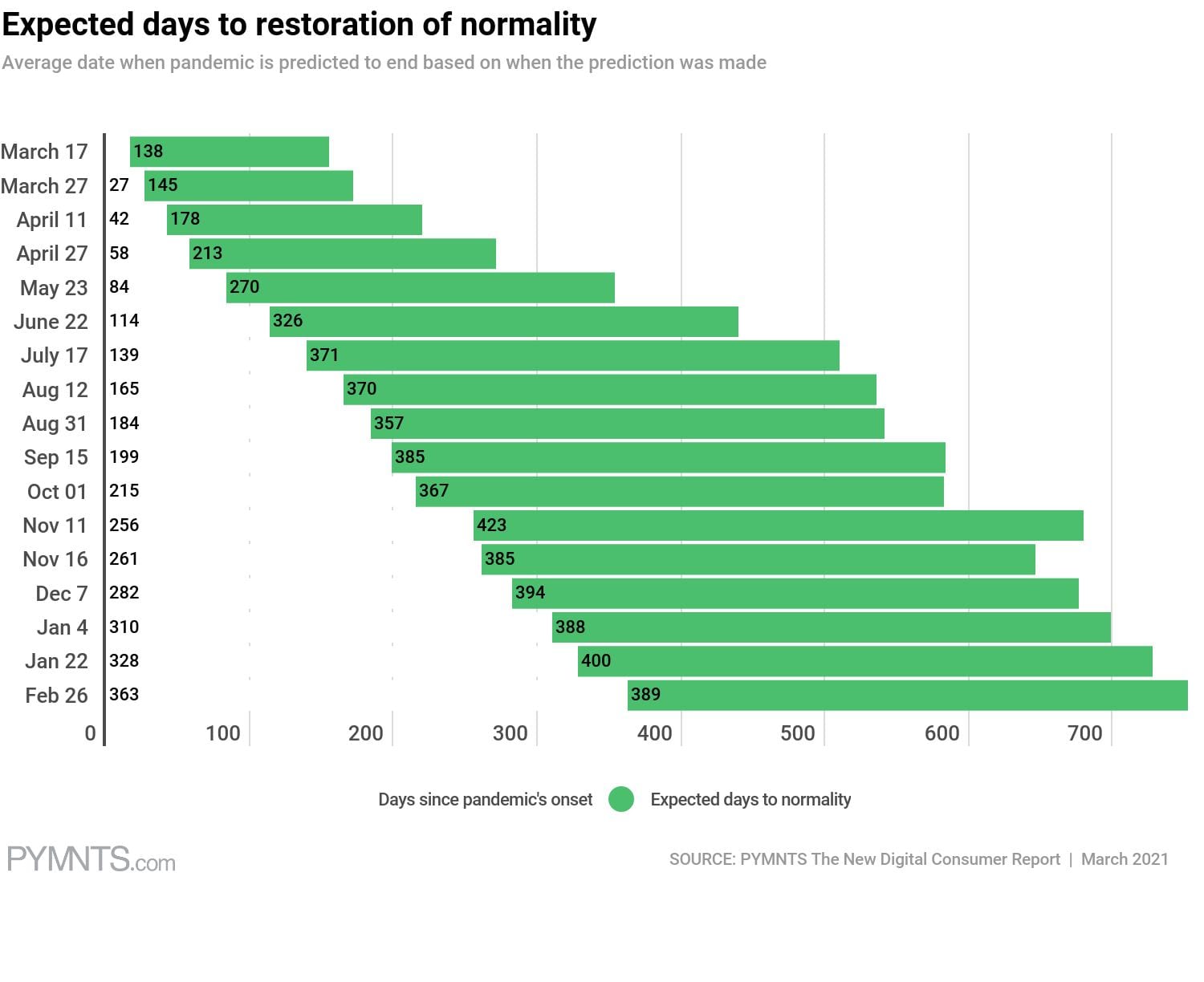 That’s one of the big headlines from PYMNTS’ latest installment (the tenth) in our year-long research project exploring the impact of COVID-19 on consumers’ retail, grocery shopping and restaurant behaviors. PYMNTS studied a population-based sample of nearly 22,000 consumers, starting on March 6 over a 12-month period, to methodically measure the U.S. consumer’s shift to digital for buying retail products, grocery shopping and eating food from restaurants. And to better understand when they think that the physical economy, as it used to be, will reopen.
That’s one of the big headlines from PYMNTS’ latest installment (the tenth) in our year-long research project exploring the impact of COVID-19 on consumers’ retail, grocery shopping and restaurant behaviors. PYMNTS studied a population-based sample of nearly 22,000 consumers, starting on March 6 over a 12-month period, to methodically measure the U.S. consumer’s shift to digital for buying retail products, grocery shopping and eating food from restaurants. And to better understand when they think that the physical economy, as it used to be, will reopen.
We have consistently found that the consumer’s instinct for when things in the physical world will truly return to how they define normal is generally more pessimistic than that of most pundits, governments and the hopeful speculation of the business community.
And, at least so far, it’s generally more realistic.
Reading The Wrong Tea Leaves
At the start of the pandemic, in March of 2020, when governments said the shutdown would last two months, the U.S. consumer said it would be more like August before things would reopen.
In June of 2020, when the conventional wisdom called for a reopening by the end of the year, the average U.S. consumer added about six months to that timeline. In December of 2020, they added 13 months.
Based on survey data from Feb. 26, 2021, the average U.S. consumer added another year. That’s March of 2022. (Those who have been or plan to be vaccinated said it would be a month earlier.) Definitely not this summer.
And that was their projection despite news at the time of the study that everyone who wanted a vaccine could get one by summer and that the COVID curve had started to flatten, with some states loosening reopening restrictions.
So, what’s the disconnect?
For consumers, returning to the physical world doesn’t seem to be based on state governments lifting restrictions, or their reassurances that there will be enough supply for all adults who want a vaccination to get one. It seems to be about the experiences that consumers will find when they remerge — and the restrictions that may still exist when they do, how many people will get the vaccine when eligible and whether variants will pose another COVID threat.
More than half (57.6 percent) of the consumers we studied say they need to see case counts come way down as a sign that “normal” will return. As many in February of 2021 say the CDC needs to say the coast is clear than did when COVID was declared a global pandemic last March.
More consumers in February (58 percent) say that the fear of getting the virus keeps them from shopping in stores than did in November of 2020 (49 percent).
Then there’s the experience they’ll find when they reengage in the physical world.
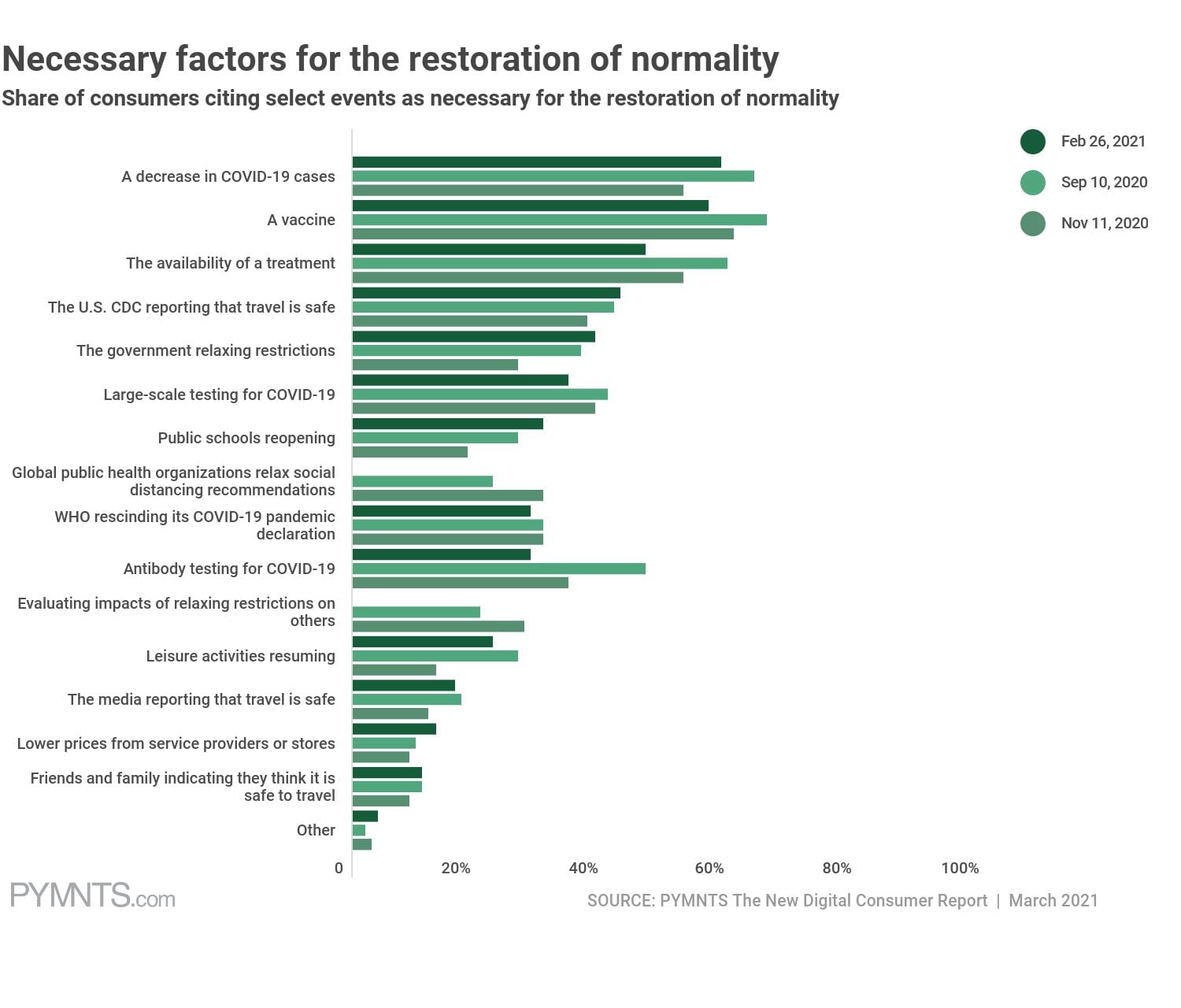
By summertime, will most store fitting rooms still remain closed or can consumers, as they once did, take clothes off the racks, go into fitting rooms and try them on? Will enough consumers feel comfortable doing that by summer even if they can?
Will reopened fitness studios still have plexiglass partitions and require masks? Will consumers be able to shower after their workouts there?
For summer vacation travel that doesn’t involve visiting family and friends, will the hotels they want to stay in be open? Will the restaurants be open and room service reinstated? Given the massive hit to small businesses worldwide, will the shops and restaurants on Main Streets in those cities and town be open — and those cities and towns be back to their pre-pandemic vibrant selves?
Of course, vaccinated consumers are ready to get out and about. More than 60 percent of the consumers PYMNTS studied who have been vaccinated or plan to say they are ready and raring to break free from quarantine. We’ve all read the stories of the vaccinated Baby Boomers and Seniors taking their post-vaccine victory laps. As more and more people get vaccinated, more and more people will be following in their footsteps and getting out and about.
It’s that pent-up demand to experience the things in the physical world for which there is no acceptable digital substitute – being tourists, going to live events, eating in a crowded restaurant on a Friday or Saturday night, going to the amusement parks with the kids — that consumers really miss.
Sure, watching a live concert inside a gaming metaverse or livestreamed on a big screen in their family rooms was better than going a year without seeing any live performances — but it isn’t even close to the experience of being in the live arena with thousands of screaming fans.
Even eating restaurant food at home from a restaurant is no substitute from eating it at the restaurant, even though PYMNTS research shows that 38 percent of consumers who once did that use restaurant mobile apps to order ahead and pick up to eat at home.
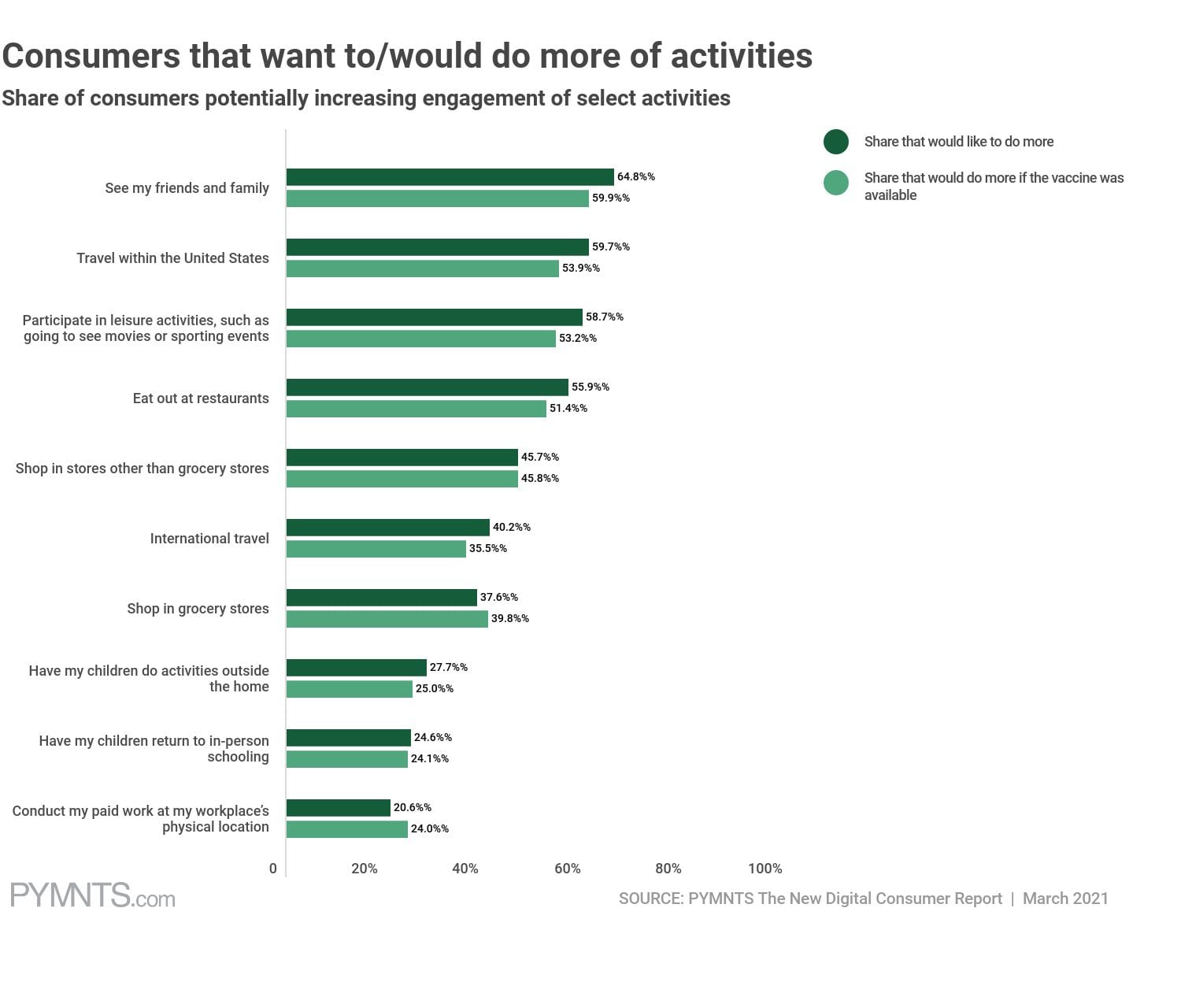
But more than simply reengaging in the physical world, consumers want a return to a physical world that is safe but also one that doesn’t include the blatant physical world reminders that COVID remains an unwelcome intruder.
That’s why most consumers believe it will take more time for them to really enjoy those experiences as they once did.
When they do, what they do will be different.
Where It’s Digital-First – And Maybe Even Digital-Always
Before the pandemic, spending data showed a consumer who was more interested in experiences over goods — more travel than trinkets, more dining out than diamonds, more concerts than clothes. As the pandemic shifted consumer spend to goods, it also shifted this experience-centric consumer’s focus to who and what made it easy for them to buy what they need while quarantined at home. Their attention turned to a whole new set of experiences and expectations: A digital-first experience defined by convenience and influenced by the brands that made it easy and safe to find and buy what they need.

Over the last twelve months, we’ve watched as consumers have honed their digital first skills across all of the categories they shop and evaluated the brands that delivered the best digital first experiences.
The result is tens of millions of now digital-first consumers whose shopping starting point is no longer the channel, but the product a consumer would like to buy.
The conversation that once started with “I have to go to the store because we are running low on paper towels” has become “We’re running low on paper towels.”
And then a decision about the easiest way to buy and get them when they are needed.
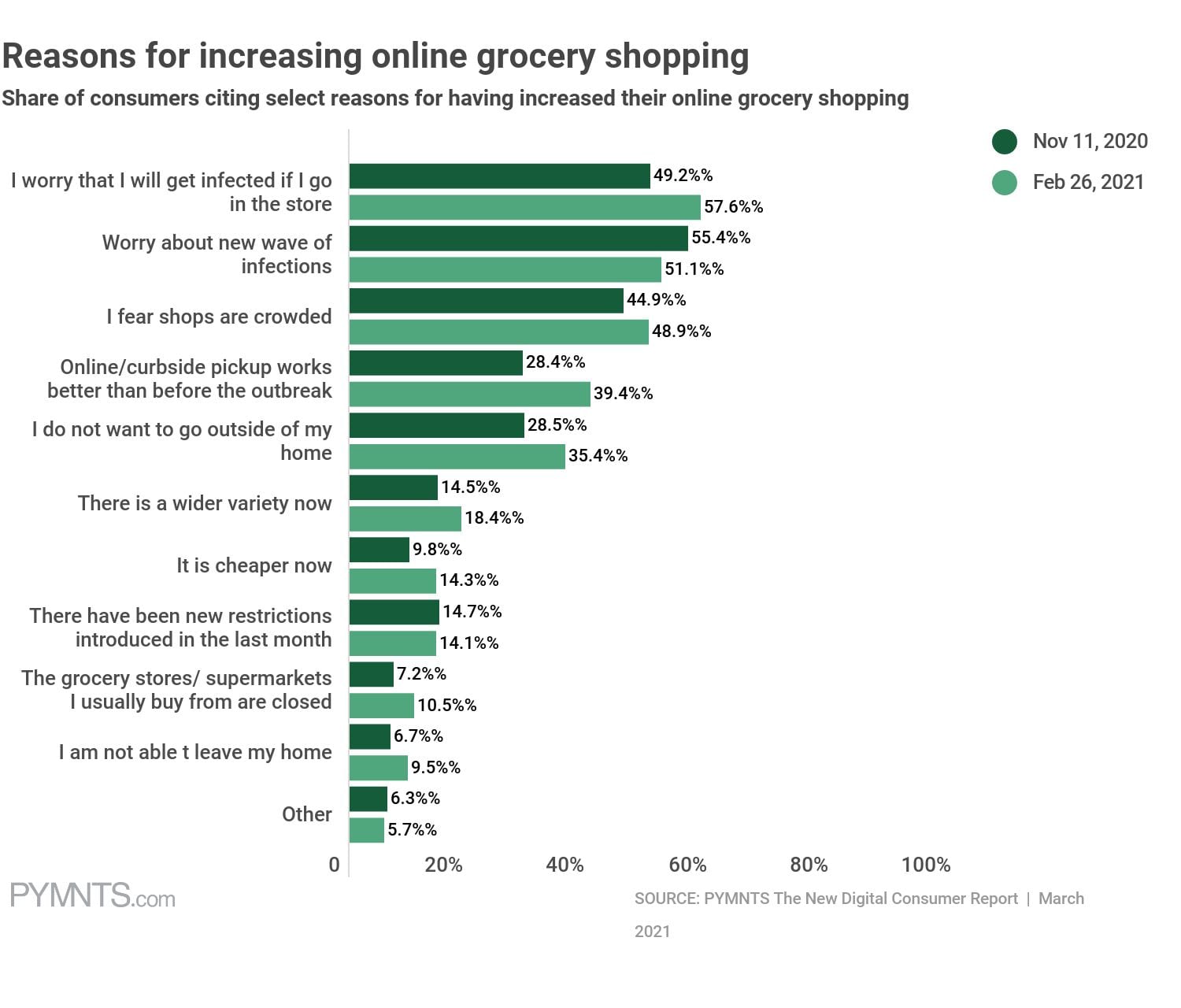
In just twelve months’ time, PYMNTS research shows that the U.S. consumer is as likely to buy anything they once bought in a physical store online. Now nearly half of all U.S. consumers have shifted to digital channels to make retail purchases, buy groceries or eat food from restaurants.
That’s consistent across generations and all purchase categories: Boomers are just as likely as Bridge Millennials to buy their clothes, electronics and even home furnishings online as they are to take a trip to the physical store to make that purchase.
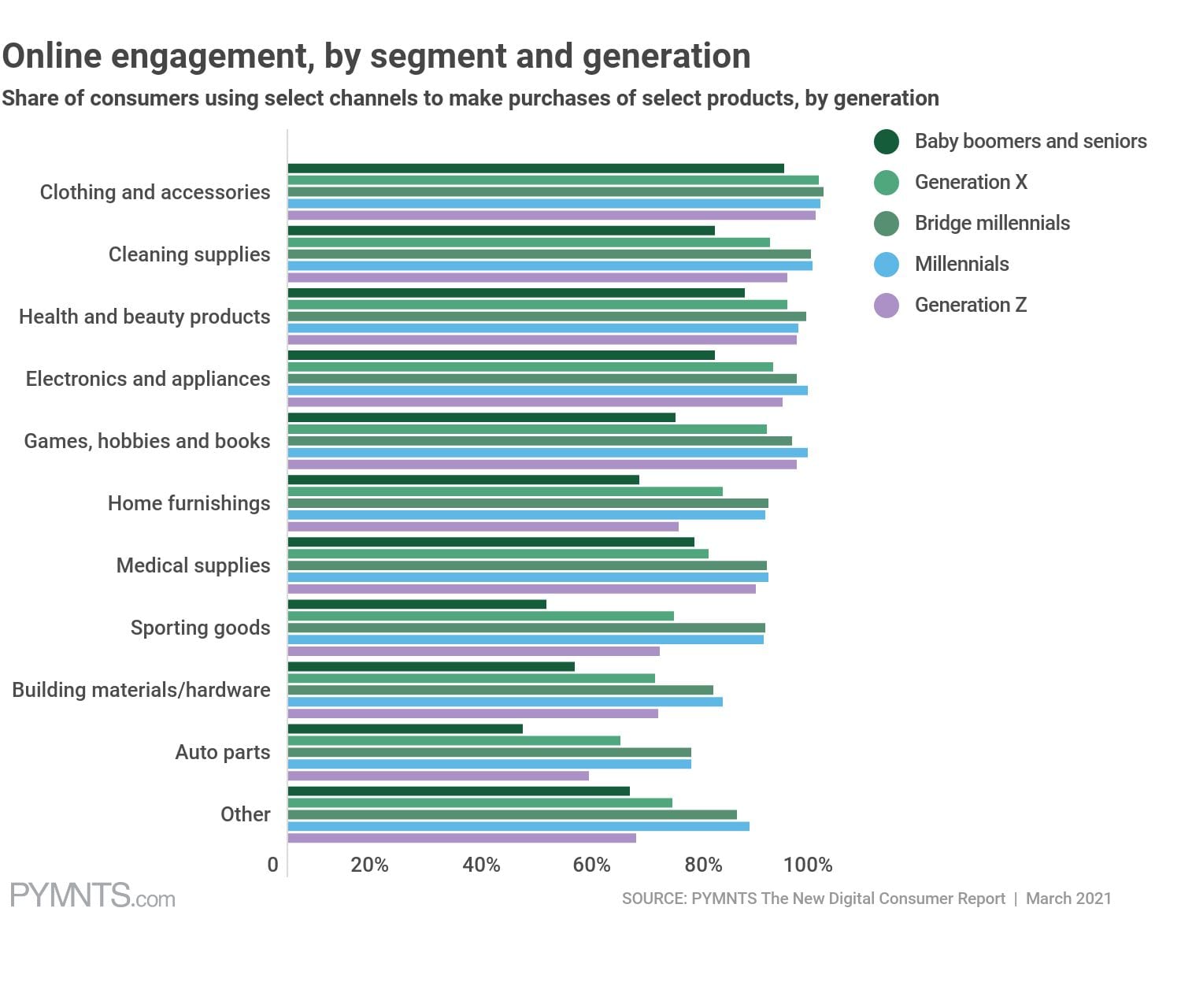 There’s also no guarantee that the physical channel consumers once preferred is their go-to in the digital-first world. The brands that make it easy and seamless for consumers to outsource those once-essential shopping purchases to a digital channel — and make it easy for them to move seamlessly across those channels — will get and keep that business.
There’s also no guarantee that the physical channel consumers once preferred is their go-to in the digital-first world. The brands that make it easy and seamless for consumers to outsource those once-essential shopping purchases to a digital channel — and make it easy for them to move seamlessly across those channels — will get and keep that business.
While they are raring to bust loose from the limitations they’ve faced from the quarantine, nearly 80 percent of them say they’ll keep all or more of their habits even as the physical economy reopens.
According to the latest PYMNTS research, 62 percent of consumers who now do less of their shopping in the physical grocery store say they won’t revert to their in-store shopping experiences even after the pandemic officially comes to an end.
It’s not just the convenience that digital channels provide that consumers like. It’s the time that consumers save when they use them.
A consumer who has now delegated many of her everyday, routine purchases to digital channels can better use that time doing other things.
Like the physical world activities that they had to give up as a result of the pandemic that don’t have acceptable digital-first substitutes.
The Competition For Consumer Time – And Spend
Harry Selfridge, who founded the iconic British department store Selfridges in 1909, was credited with ushering in a new retail shopping paradigm. Until then, department stores were mostly about making it efficient for consumers to buy what they needed all in one place.
Selfridge aimed to turn that idea upside-down by creating a destination defined by the experience of being in that store. In addition to making goods more accessible to the consumer, he equipped the store with things that made shoppers want to visit and then spend more of their time there — cushy chairs, restaurants, reading rooms, even a “Silence Room” where tired shoppers could relax and kick back. Selfridge wanted to turn shopping from something that consumers had to do to buy what they needed into something they wanted to do — and do more of in his store.
The silver lining of the pandemic is that it has given all sectors of the economy, not just retail, the opportunity to think deeply about how to use technology and people to create better customer experiences. How to use digital-first experiences to replace or enhance what could only once be done in the physical world. How to adapt physical channels to deliver a more personalized, relevant experience. How to use both to align with the consumer’s digital-first journey, regardless of the channel she starts or ends with.
That’s equally true for doctors and their patients, bankers and their accountholders, employers and their workforce, and retailers and their customers.
As the world contemplates the physical reopening of the economy, competition for the consumer will now take place on a different stage. In a world in which digital now influences the decisions consumers make about their time, the money they spend and who’ll they’ll spend it with, it will take more than a vaccine and a promise to reopen to get consumers fully re-engaged into a physical world routine.
Consumers want to recapture the experiences they’ve gone without for more than a year. But they also have tasted the efficiencies and value-added dimensions that a digital-first experience can provide and for that, there’s no turning back.
